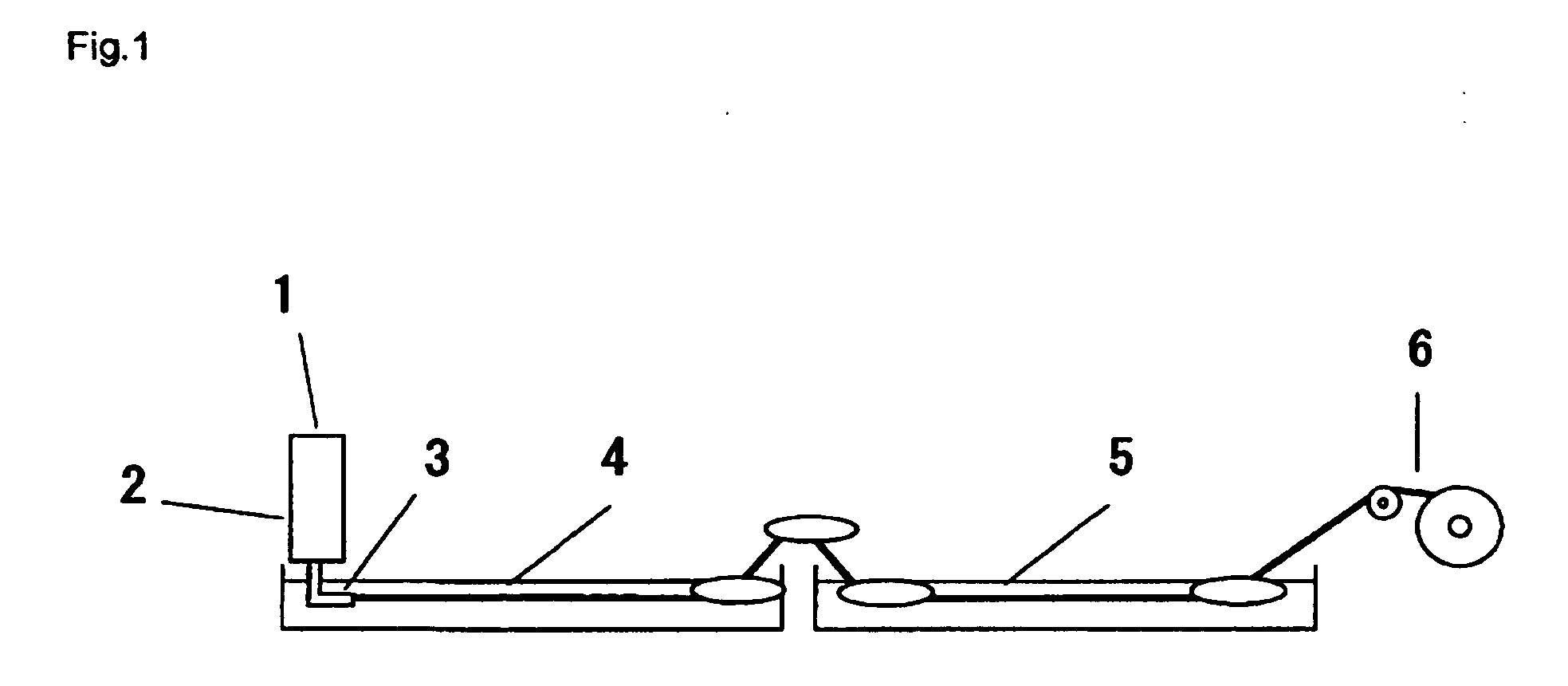Molded object comprising alpha-1,4-glucans and/or modifications thereof and process for producing the same
a technology of alpha-1,4-glucans and molded objects, which is applied in the direction of sugar derivates, transportation and packaging, organic chemistry, etc., can solve the problems of poor water resistance and strength characteristics of starch products, oligomers may harm human bodies, and injure human living, etc., to achieve easy geling, favorable moldability and properties, and excellent biodegradability
- Summary
- Abstract
- Description
- Claims
- Application Information
AI Technical Summary
Benefits of technology
Problems solved by technology
Method used
Image
Examples
example
[0136] The present invention is further explained in detail hereinafter referring to synthesis examples, examples and comparative examples, and is not limited thereto. Unless otherwise specified, “part” in each of the examples means “part by weight”, and “%” means “% by weight”.
[0137] In the production examples, a preparation method of purified glucan phosphorylase which is derived from potato, a preparation method of sucrose phosphorylase which is derived from Streptococcus mutans, a method for calculating a yield (%) of α-1,4-glucan and methods for measuring weight-average molecular weight (Mw) and number average molecular weight (Mn) were followed known methods described in JP Kokai 2002-345458. For details, molecular weight of synthesized glucan was measured in the following way. First, synthesized glucan was completely dissolved in 1N solution of sodium hydrate, and the resulting solution was neutralized using appropriate amount of a solution of hydrochloric acid. The resultin...
production examples 1-5
Synthesis of α-1,4-Glucans
[0140] To a reaction solution (1 liter) containing 6 mM of phosphate buffer solution (pH 7), 106 mM of sucrose and maltooligosaccharide mixture with various concentration (880, 149, 132, 8.8 or 4.1 mg / liter), purified glucan phosphorylase derived from potato tuber (1 unit / ml) and sucrose phosphorylase derived from Streptococcus mutans (1 unit / ml) were added and kept at 37° C. for 16 hours. After the reaction was completed, a yield (%), a weight-average molecular weight (Mw) and a molecular weight distribution (Mw / Mn) of resulting α-1,4-glucans were determined. The results were shown in Table 1.
[0141] Table 1 shows that α-1,4-glucans having Mw of 11.0 to 780.5 kDa were obtained by changing concentration ratio of sucrose and primer (i.e., maltooligosaccharide) in the reaction. The molecular weight distributions (Mw / Mn) of the obtaining α-1,4-glucans were sharp (All Mw / Mn were not greater than 1.05.).
TABLE 1maltooligo-saccharidemixtureYielddegree ofSamplem...
examples 1 and 2
[0142] Powders produced from Production example 1 and Production example 4 were mixed at weight ratio of 50:50, and 15 g of the resulting mixture was picked up and was dissolved in 85 g of 1N sodium hydroxide solution to prepare a stock solution. The stock solution was spread over the glass plate in a thickness of about 0.6 mm, and the plate was soaked into a vat filled with 1N hydrochloric acid solution for about 1 minute to gel. The resulting film-like gel was washed with flowing water, and dried in a desiccator with a rack at 50° C. to obtain a transparent film having a thickness of 50 μm (Example 1). A similar procedure was performed by using powders produced from Production example 1 and Production example 3 (at weight ratio of 50:50) to obtain a film (Example 2).
PUM
| Property | Measurement | Unit |
|---|---|---|
| Molecular weight | aaaaa | aaaaa |
| Degree of polymerization | aaaaa | aaaaa |
Abstract
Description
Claims
Application Information
 Login to View More
Login to View More - R&D
- Intellectual Property
- Life Sciences
- Materials
- Tech Scout
- Unparalleled Data Quality
- Higher Quality Content
- 60% Fewer Hallucinations
Browse by: Latest US Patents, China's latest patents, Technical Efficacy Thesaurus, Application Domain, Technology Topic, Popular Technical Reports.
© 2025 PatSnap. All rights reserved.Legal|Privacy policy|Modern Slavery Act Transparency Statement|Sitemap|About US| Contact US: help@patsnap.com

